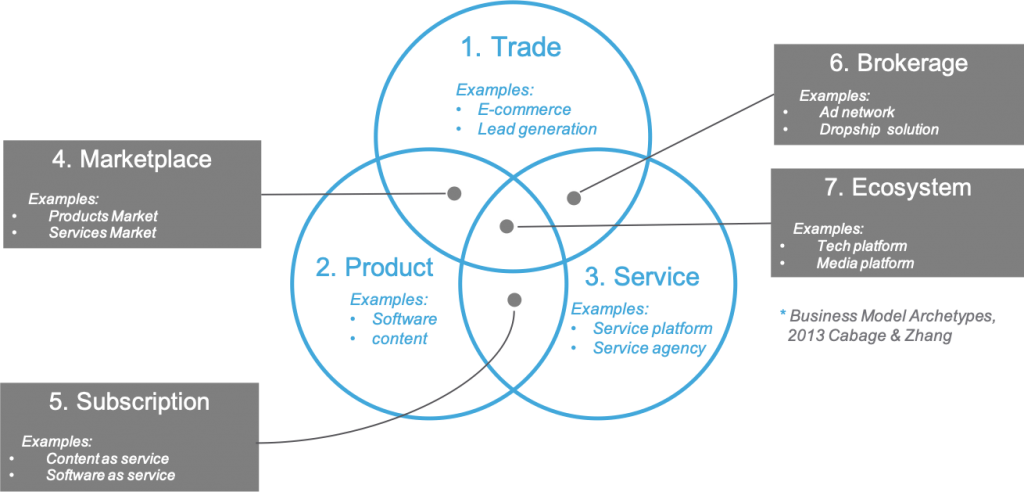
In simple terms, a business model may be described as the plan that you have in place for your business. It is a conceptual framework that captures how you intend to create and deliver value as a company. It explains what consumer needs that you intend to help with and clarifies the viability of your company or product.
Using a business model, you paint a picture of where you belong in the overall market setting. It describes business inputs, expected customer base, and other details, including financing and sources of revenue. A model enables easy identification of strengths, weaknesses, opportunities, and threats through comparisons with similar organizations.
There is a variety of business models available and more are still being added. However, in spite of their helpfulness, many product managers know little about them. Only those that had formal training on business strategy usually know about most of these models.
The Business Model Archetypes
The Business Model Archetypes model was introduced by Neal Cabage and Sonya Zhang in the book The Smarter Startup, and provided a framework for classifying high-level categories of business models that share common attributes – it’s a great place to begin thinking about and understand your business.
Business Model Archetypes is an adaptation of Jung’s personality theory, applied to business. It outlines seven archetypes that portray diverse types of businesses. The framework identifies three primary business personalities or archetypes, three secondary, and one tertiary.
The primary archetypes capture the most important business interests and activities. As for the secondary archetypes, they combine some attributes of different primary archetypes in one. The tertiary archetype has attributes of all three primary ones.
Primary
Product – This concerns the development of an artifact that solves a generalized problem for a large audience, and making it available for purchase for a one-time fee or cost. The value proposition of products typically has to do with increasing productivity or providing entertainment or convenience.
Service – This archetype has to do with solutions or work, often manually, or providing intangible solutions on an on-going basis, for a fee or unit cost basis rather than an up-front sunk cost. Value proposition comes in form of customization, integration, or maintenance.
Trade – What this focuses on is linking sellers to buyers, or vice versa. The value proposition of this archetype includes curation, low price, and convenience. It involves getting products at lower prices and selling for a profit while providing the above values, among others.
Secondary
Brokerage – This archetype is an intersection between service and trade. Businesses here often help brands conduct trading as a service in return for a fee. An example is an advertising network.
Subscription – This combines attributes of a product and service. Platform support and customization are the major value propositions. Software as a service (SaaS) falls within this model.
Marketplace – Here you have a blend of trade and product attributes. The archetype represents a platform (a product), including self-serviced, that enables a connection between sellers and buyers for trade.
Tertiary
Ecosystem – This last archetype is less common but indicative of a dominant and established solution provider. It shares attributes of all three primary archetypes. An example would be developing a piece of software, offering services to support it, and then promoting marketplace activities when the ancillary services become successful as well. A company for example may sell a popular product, provide custom services solutions in support of the product, as well as a marketplace for 3rd party augmented solutions.
Apart from value propositions, key partners, activities, and monetization techniques differ among these archetypes.
Business Model Archetypes in Practice
This model can be useful for making out the broad context and then deciding what to focus more on in your business strategy. It helps you to properly analyze a broad spectrum of options and possibilities to identify the more actionable and beneficial one(s).
Cabage & Zhang added a pair of prototypes in his framework to give a clearer picture of what can be done in each archetype. Product, for instance, has software and content as prototypes. These represent things that provide value and which you can sell to users.
If you take a closer look at these archetypes, you are very likely to find one that your team can relate more with. It is, however, possible to operate within more than one archetype. For example, a business using a trade model may also adopt a brokerage model for expansion.
The principal aim of the Business Model Archetypes is to enable proper analysis and understanding of your business’s main function within your market. It provides clarity on what possibilities are worth focusing your efforts on.


